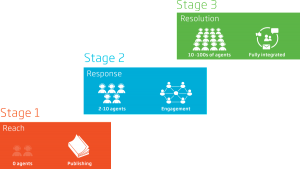Vaccination rates are on the rise; as I write, nearly half of the US population is reported as fully vaccinated against Covid-19. While concerns still linger about Covid variants and the possible need for booster shots down the road, we’re gradually working our way back toward some sense of “normalcy” in the market.
Even as workers return to the office and businesses open back up to their full capacity, though, we have to acknowledge permanent changes in the market resulting from the pandemic. For instance, many consumers embraced card-not-present (CNP) channels like eCommerce and click-and-collect during the lockdowns. And, although some consumers will return to their pre-pandemic habits, many found that they enjoy the convenience and ease-of-use associated with these channels. These shoppers will make the jump to CNP commerce a permanent move.
That’s great news if you operate in the CNP space, right? Well, there are still drawbacks that we need to consider. We see that reflected by the state of chargebacks in the post-Covid landscape.
The State of Chargebacks in 2021
Most respondents who participated in a recently-released study from Chargebacks911 were willing to chalk up some increase in transaction disputes to Covid-19. In fact, the average merchant reported a 25% increase in chargeback issuances.
Between 2018 and 2021, eCommerce merchants noted a 21% increase in criminal fraud activity. Even more concerning, chargeback abuse carried out by cardholders rose by 23% during the same period. This could be tied to a variety of factors, from simple misunderstandings or confusion about merchant policy, to deliberate abuse of the chargeback process.
The forecast doesn’t look great for the rest of 2021, either. According to the survey, more than half of all merchants have a pessimistic outlook regarding their business prospects for the remainder of the year.
The pessimism is understandable…but that doesn’t mean it’s necessary. There are numerous opportunities at hand to optimize practices, reduce costs, and improve your business. This is especially true for your card-not-present operations over the next year (and beyond). The trick is to leverage them effectively.
Opportunity is There…if You Know Where to Look
According to the study, the average merchant said they re-present disputed transactions in 43% of cases. However, the average net recovery rate, or the rate of successful representment as a share of total chargebacks issued, sat at just 12%. This is despite the fact that more than half of all chargebacks are cases of friendly fraud.
The problem is that merchants lack data insight. Most don’t have access to the kind of in-depth transaction data that can help them pick out frivolous disputes. Even if they did, most don’t have the time or resources to parse that data and build out strong cases for representment.
Higher-level data sharing within the industry could make for a much more robust and egalitarian solution for chargebacks. In the meantime, though, you can reduce costs associated with chargebacks by taking the following steps:
#1. Adopt a Multilayer Fraud Solution
You should deploy fraud detection tools in a strategic manner. No single tool is perfect, but with multiple tools working as part of a coordinated strategy, they can offer a much more reliable picture of each transaction’s risk profile. This includes tools like 3-D Secure technology, geolocation, Address Verification Service (AVS), velocity limits, and device fingerprinting. You should also deploy fraud scoring, which can allow for easy decisioning based on transaction risk.
#2. Use Alerts & Inquiries
Chargeback alerts notify you of pending disputes, allowing you to refund buyers and avoid a chargeback. The network inquiry programs (Order Insight through Visa, and Consumer Clarity for Mastercard) fulfill a similar role. The study found that the use of alerts resulted in a 19% reduction in chargebacks on average, while inquiries led to a 17% reduction. Both can be used side-by-side for compounding defense.
#3. Double-Down on Customer Service
Business best practices can help prevent many disputes. This includes developing a clear, yet flexible return policy, using tracking and delivery confirmation for shipping, and following up on any complaints or bad reviews. You should provide responsive, helpful live service across all communication channels. Finally, ensure that all product descriptions are detailed and accurate, and accompanied by high-res images showing all products from multiple angles.
#4. Provide a Supportive Work Environment
The success of all your operations will depend on your team’s hard work. Remember to be flexible and sensitive to workers’ needs as they and their families continue to adjust. You can even help alleviate a lot of stress and anxiety by assisting with childcare, transportation, or fitness and wellbeing. You could also consider offering additional PTO time to allow workers to decompress more often. Yes, it would be an up-front cost…but it could pay dividends.
Change is the Nature of the Market
Adjusting to the post-Covid marketplace won’t be easy. It demands new approaches to old processes, and a doubling-down on fundamentals like customer service and fraud prevention. Of course, we shouldn’t get too overfocused on Covid-19; while the pandemic has been a transformative experience, many of the trends we’re seeing now were already underway before the virus.
Yes, the eCommerce space is changing. But then again, rapid and transformative change has always been the ethos of eCommerce. So, while adapting to the circumstances imposed by Covid-19 hasn’t been easy, ongoing short- and long-term adaptation is to be expected.
Digital & Social Articles on Business 2 Community
(145)
Report Post





